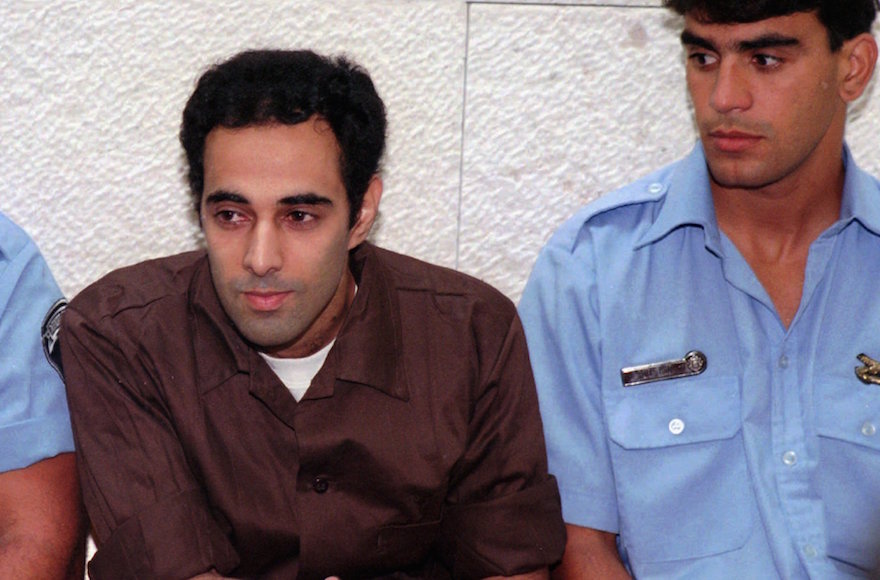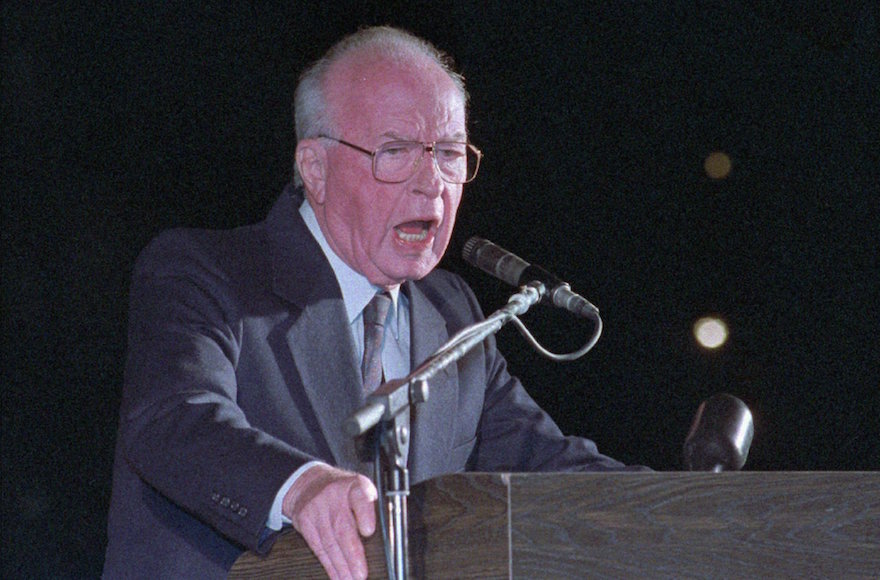The assassination of President John F. Kennedy shocked the American public; the assassination of Prime Minister Yitzhak Rabin reshaped Israel’s.
This week, the long-running, long-form radio journalism program “This American Life” examines the circumstances surrounding Rabin’s 1995 assassination and its imprint on Israeli politics, policy and psyches.
The episode, called “The Night in Question,” is narrated by Nancy Updike, a producer of “This American Life,” and her husband, Dan Ephron, a former Jerusalem bureau chief for Newsweek and author of the book “Killing a King: The Assassination of Yitzkak Rabin and the Remaking of Israel,” which arrives this week.
For the hourlong episode, Updike and Ephron speak to a number of people involved in the events of Nov. 5, 1995, when Rabin, who had just finished speaking at a peace rally in Tel Aviv, walked off the stage to his waiting car and was shot twice in the back.
The couple considers the many conspiracy theories swirling around the murder and why so many Israelis (a third of the general public; half of religious Jews according to polls) are still inclined to believe them. And they analyze how Rabin’s death has reconfigured Israel’s identity and rerouted its course as a country.
The episode’s prologue begins at the home of the assassin, Yigal Amir. Amir is still in prison, but his brother and co-conspirator Hagai Amir, who was released a few years ago, proudly shows Updike and Ephron the shed where he and his brother plotted the crime for two years and handcrafted some of the munitions.
“We wanted to do it,” Amir tells them. “It didn’t happen by accident. We did it to save Jews, to stop this process that was killing Jews.”
The process he is referring to is the Oslo Accords, the second part of which Rabin and Palestinian leader Yasser Arafat signed weeks before the assassination. At the time of the murder, the country was split 50-50 in its support and opposition to the accords.
“The brothers are still unapologetic about what they did,” Ephron says. “They killed the prime minister because they didn’t like his peace deal.”

Yigal Amir, convicted for the murder of Israeli Prime Minister Yitzhak Rabin, is flanked by two prison warders at the first hearing of his appeal to the Israeli Supreme Court in Jerusalem, July 7, 1996. (Eyal Warshavsky/AP Images)
The case against Yigal Amir seems clear cut: He was caught on video raising a gun to Rabin. He calmly confessed to the police, reenacted the crime for them and never recanted his testimony.
Still, many people don’t believe him. The list of “loose ends” from that night is long: claims that the bullets were blanks, witnesses who say they didn’t see blood on the scene, an abnormally long drive to a very close hospital. Israelis and the media have long been captivated by conspiracy theories.
Ephron and Updike debunk some of the major ones in their report. Ephron, who does not buy into the claims, admits to a moment of doubt when Dalia Rabin, the prime minister’s daughter, lays Rabin’s bloodstained and bullet-ridden shirts on a table. In addition to the holes in the back, there’s a mysterious third hole in the front.
But after taking the clothing to a forensic specialist in Arizona for extensive testing, Ephron concludes: “It’s not a bullet hole. Rabin was not shot in the front.”
The reporters speak to Moti Naphtali, the investigator who first interrogated Yigal Amir immediately following the shooting. When Naphtali informed Amir that Rabin had died, he tells Ephron and Updike, Amir raised his Styrofoam cup of tea. “He said, ‘Let’s make a toast. L’chaim,’” recalls Naphtali. “To life. To life that he took.”
They also spoke to Menachem Damti, Rabin’s driver that night, who recounts the silence in the car as Rabin lay bleeding in the back, and who is haunted by a mistaken left turn he made that prolonged the drive to the hospital and fueled one of the conspiracy theories.
While Damti turned left that night, the country has since slowly turned right.
“After Rabin died, our path to the future was clearer than it ever was before,” activist Daniella Weiss tells Updike and Ephron. “We won the land, and we won the politics.” For 40 years, Weiss has been a vocal proponent of expanding settlements.
In 1975, when Rabin was prime minister for the first time, he opposed the settlements, famously calling them a “cancer in the tissue of Israel’s democratic society.” Then, Weiss was on the fringe of Israeli society. At a campaign rally before the recent elections, she introduced Prime Minister Benjamin Netanyahu.
The left constitutes 15 percent of the country, Ephron and Updike report. Now, “the left is the fringe.” When Kennedy was killed, America stayed more or less on the same path. When Rabin was killed, his ideology died with him.
JTA has documented Jewish history in real-time for over a century. Keep our journalism strong by joining us in supporting independent, award-winning reporting.






